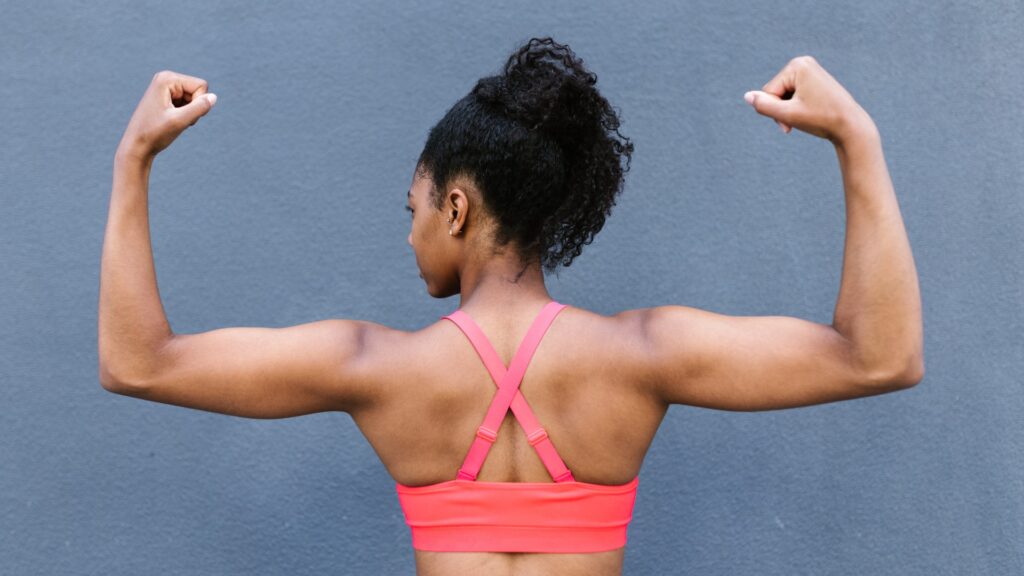There can be many reasons you may have exercise-related muscle soreness, but some of the most common include:
- Performing new exercise
- Performing more intense exercise
- Overtraining in exercise performance.1,2
Most muscle soreness is believed to result from microtears in the muscle fibers that happen when we exercise.3,4 While this may sound concerning, it’s actually part of how muscles grow. When these tiny tears occur, the body’s natural repair process kicks in. Blood flow to the area increases, delivering oxygen and nutrients to help the tissue heal. Muscle stem cells, called satellite cells, activate and fuse with the damaged fibers, promoting regeneration and growth. Over time, as the muscles repeatedly repair and adapt, they become larger and stronger.5
You may feel some soreness during or immediately after exercise, but don’t be surprised if muscle soreness happens the day after your workout. This is called delayed-onset muscle soreness (DOMS). DOMS is different than the discomfort you may experience during exercise, but it’s quite normal when you’ve done activity that places new stress or load on your muscles.3
So, what can you do about muscle soreness? Here are 5 tips for managing muscle soreness:
1. Begin gradually
Begin gradually when starting any new type of exercise or exercise program.
Though it might be tempting to get going and give it your all-out effort, progressing gradually will reduce your risk of injury and minimize soreness. It’s important to give your muscles time to adapt to the new stress being placed on them.3,4
2. Perform a dynamic warm-up and active cooldown
The purpose of warming up before exercise is to encourage blood-flow, lubricate the joints, and improve muscle elasticity. Before exercise, do a dynamic warm-up, which consists of doing a few minutes of activity that gradually raises your heart rate, like low-intensity walking, and then moving your joints through a large range of motion, like performing a few lunges, leg swings, and arm circles.1
The purpose of an active cool down is to gradually bring down your heart rate and blood pressure and circulate cellular waste products that accumulate in the muscles during a workout. Even if you don’t feel sore after a workout, these waste products can cause fatigue during your next workout, so it’s important to have a short cool down.1 Gradually bring your heart rate down by slowing the pace of your activity incrementally for a few minutes at the end of aerobic activity. If you’ve been performing resistance-type exercises, try actively cool down by walking on a treadmill or pedaling on a bicycle for 5-10 minutes. After the active cool down, you may also want to stretch the muscles you’ve been using to keep the muscles and tendons mobile.1 These stretches should be done in a slow, controlled manner, holding for at least 60 seconds (which can be done in sets of 10-30 seconds).1
3. Hydrate properly
It’s important to hydrate before, during, and after exercise. Hydration before you exercise can help you perform at your best. Not being properly hydrated before exercise can adversely affect how you perform, especially in hot, humid conditions.1 It’s also important to drink water during and after you exercise to replenish the fluids you lose when you sweat and ensure proper hydration recovery.
4. Allow muscles time to recover
Your muscles need time to recover and repair – remember this is how we build them. To support muscle recovery, avoid doing the same type of exercise on consecutive days. This doesn’t mean you have to skip workouts – just switch up your routine by targeting different muscle groups or doing a different type of exercise for 2-3 days before repeating the same workout.3 For example, if you did resistance training today, try going for a walk or doing another aerobic-type workout tomorrow. You can also vary your resistance training by rotating focus—one day on lower-body exercises, the next on upper-body exercises, and another day focusing on your core.
The exception is if you’ve been overtraining, which occurs when you push your body too hard without enough rest.2 Too much overload or not enough rest and recovery can result in soreness, stiffness, fatigue, and decreased exercise performance and ability. In this case, you may need an extended period of rest. If you are feeling completely wiped out after a hard workout, listen to your body – you may need to prioritize rest and recovery.2 Consult your health care provider if symptoms are ongoing.
5. Consider recovery techniques and treatments
Some forms of recovery that may help with sore muscles include the following:
- Ice pack application4 – Ice packs can be applied to sore muscles to decrease inflammation and swelling by reducing blood flow to the sore area. It’s recommended to apply ice to sore muscles for 10–15 minutes several times a day. To protect your skin, place a cloth or paper towel between the ice and your skin.6
- Foam rolling and other myofascial release tools and techniques1,4 – A foam roller (and other myofascial release tools) can be used by and individual rolling and applying gentle pressure to relax muscles, improve blood circulation, improve joint range of motion, reduce soreness, improve muscle recovery, and decrease pain and tenderness.1,7
- Massage therapy1,4 – Massage therapy is done by a professional and can also be an effective recovery strategy. Research suggests that massage can help ease muscle soreness by activating the part of the nervous system that promotes relaxation and recovery. It also boosts blood and lymphatic flow, which can help clear out substances linked to muscle damage, speeding up the healing process. Massage therapy can also reduce inflammation and help muscles recover faster. It may also lower pain by triggering the body’s natural pain relief responses. Some studies suggest that it can even improve muscle strength and performance after exercise, although more research is needed to confirm this.8
When starting your exercise routine, be sure to start gradually, warm up before and cool down after, drink plenty of water, allow for rest and recovery, and use tools to ease soreness and help with muscle recovery.
Want to start a new exercise program? Try one of our free programs to progress in your healthy journey.
Infographic
Download the PDF or share the image below to help others learn more about 5 tips for managing sore muscles.
References
- Alencar, Michelle, and Jordan Valle. “A Road Map to Effective Muscle Recovery.” American College of Sports Medicine. Docslib, 2019, docslib.org/doc/629829/a-road-map-to-effective-muscle-recovery.
- Roy BA. Overreaching/Overtraining: More Is Not Always Better. ACSM’s Health & Fitness Journal 19(2):p 4-5, March/April 2015. | DOI: 10.1249/FIT.0000000000000100.
- DeSimone GT. Shareable resources: Sore and more. ACSM’s Health & Fitness Journal 21(3):p 5, May/June 2017. | DOI: 10.1249/FIT.0000000000000287.
- Braun, W and Sforzo G. ACSM information on delayed onset muscle soreness (DOMS). American College of Sports Medicine, 2011. Retrieved December 14, 2024 http://www.acsm.org.
- Damas F, Libardi CA, Ugrinowitsch C. The development of skeletal muscle hypertrophy through resistance training: the role of muscle damage and muscle protein synthesis. Eur J Appl Physiol. 2018;118(3):485-500. doi: 10.1007/s00421-017-3792-9.
- Hinge Health. Ice or Heat for Sore Muscles: What Should You Use?” Hingehealth, 18 Jan. 2024, www.hingehealth.com/resources/articles/heat-or-ice-for-sore-muscles/.
- Stacey, Penney. “NASM | Guide to Foam Rolling.” National Academy of Sports Medicine, www.nasm.org/docs/default-source/pdf/nasm-guide-to-foam-rolling.pdf?sfvrsn=6. Accessed 1 Apr. 2025.
- Guo J, Li L, Gong Y, Zhu R, Xu J, Zou J, Chen X. Massage Alleviates Delayed Onset Muscle Soreness after Strenuous Exercise: A Systematic Review and Meta-Analysis. Front Physiol. 2017 Sep 27;8:747. doi: 10.3389/fphys.2017.00747.



